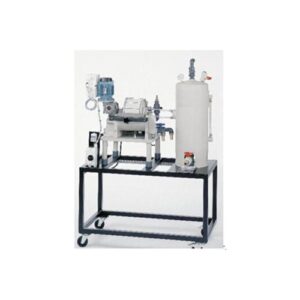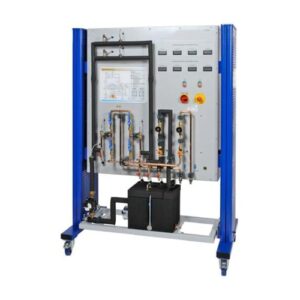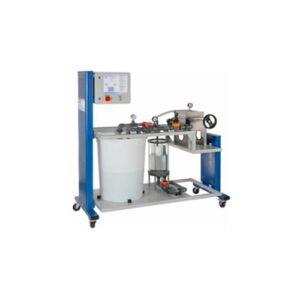ET 262 Geothermal Probe With Heat Pipe Principle Vocational Training Equipment
In shallow geothermal energy generation the thermal energy stored under the earth’s surface is used for heating purposes.
ET 262 demonstrates the operation of a geothermal probe with heat pipe principle. The transparent experimental set-up provides an insight into the closed circuit of the heat transfer: it allows a clear view on the evaporation in the heat pipe, the condensation in the probe head and the reflux of the heat transfer medium on the inside wall of the heat pipe. The set-up also allows to take a closer look at the basic methods applied for determining the thermal conductivity of the surrounding soil of the geothermal probe.
The heat pipe whose operating behaviour is examined constitutes the core element of the trainer. The heat pipe contains a low-boiling heat transfer medium. The heat input from the soil is simulated via a temperature control jacket with heating circuit. The heat from the heat transfer medium is transferred to a working medium inside the probe head. Sensors detect the temperature and flow rate of the working medium in the heat exchanger. These measured values are used to calculate the thermal power that is transferred. The software uses the measured values to simulate the energy balance of a connected heat pump.
One method to determine the thermal conductivity of the surrounding soil is the so-called thermal response test. A pump circulates constantly heated water through a U-tube geothermal probe that is sunk in sand.
During this process, the inlet and outlet temperature, the flow rate and the heating power of the geothermal probe are recorded. These measured values are used to calculate the thermal conductivity.
During another experiment, a sand cylinder is heated with a cylindrical heat source. The radially dispersed thermal temperature profile within the sand sample is detected and used to calculate the thermal conductivity within the sand sample. The results of both methods will then be compared. The measured values are transmitted directly to a PC via USB where they can be analysed using the software included.
Specification
demonstration of the operation of a geothermal probe with heat pipe principle heat pipe made of glass with transparent temperature control jacket water as a working medium for heat dissipation in the heat exchanger supply of the working medium via the lab network or via water chiller WL 110.20 to ensure a maximum water temperature of 16°C simulation of the energy balance of a heat pump in the software refrigerant AR1233zd, GWP: 1 software for data acquisition via USB under Windows 8.1, 10
Technical data
Heat pipe length: approx. 1000mm Ø external, heat pipe: approx. 56mm Ø external, temperature control jacket: approx. 80mm Heater in the heating circuit output: 2kW Pump in the heating circuit max. flow rate: 1,9m3/h power consumption: 58W U-tube geothermal probe made of copper length: approx. 1000mm Pump in the thermal response test flow rate: 4,8…28,2L/h power consumption: max. 60W Heating element in the water tank output: 100W Heating element in the sand container output: 50W Refrigerant: AR1233zd, GWP: 1
filling volume: 2,3kg ACO2-equivalent: 0t Measuring ranges temperature of the heating element in the sand sample: 0…250°C flow rate: 0,4…6L/min 230V, 50Hz, 1 phase 230V, 60Hz, 1 phase; 120V, 60Hz, 1 phase UL/CSA optional











